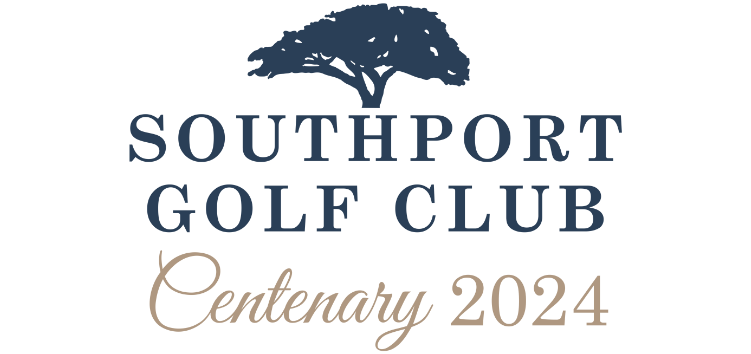
Southport Golf Club is formed in August 1924
A group of local and Brisbane residents formed the Southport Golf Club on August 23, 1924.
The formation of the Southport Golf Club was reported in The Telegraph in Brisbane on August 26, 1924.
A general meeting of the newly formed Southport Golf Club was held in the School of Arts on Saturday. Dr. R. S. Berry presided. A number of Brisbane golfers came down for the occasion. The following provisional officials. were elected: Patron, the Hon. J. G. Appel; president, Mr. Les. James; vice-president, Dr. R. S. Berry; hon. secretary, Mr. H. S. Bere; treasurer, Mr. E. H. White; captain, Mr. J. N. Radcliffe; provisional committee, Messrs C. G. Barnes, L. Cosgrave, and H. Saltmarshe. The Provisional Committee were instructed to draft a constitution and submit it to a general meeting for approval. It was decided to make the annual subscription £3 3s., while the fee for associate members was fixed at £2 2s., and that of country members £1 1s. The secretary reported that already over 50 persons had signified their intention of joining…
Photo: Brisbane Telegraph, August 26, 1924.
It is interesting to note that Associates were able to join the club from its beginning.
The combination of local and Brisbane members was indicative of the importance of having a golf course to enhance the sporting offerings for tourists from Brisbane. The earliest golf carnivals were held at Christmas and Easter, when Southport had the greatest numbers of visitors.
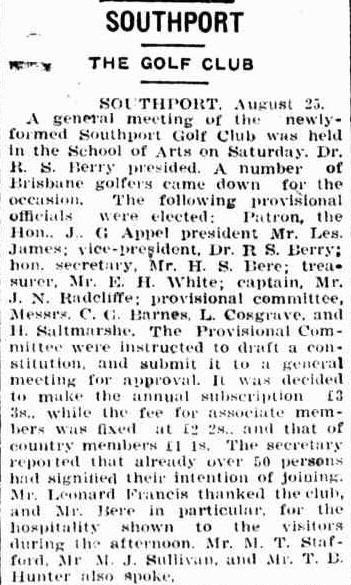
Growth of the Club
In the space of a year, the Southport Golf Club had more than doubled its membership. On December 5, 1925, the Brisbane Courier noted, “the membership at the present is about 120, which includes full playing, associate, and country members, and the first annual meeting was held at the Pacific Hotel, Southport last night. Scott, the professional, is daily in attendance at the links, and members have the option of taking the lessons they wish at a nominal fee.”
In August 1924, the newly formed club planned to establish temporary links at the show grounds (now Owen Park), and they also played golf at the Southport links, our current site. South Coast Golf Recreations owned and ran the golf course at our current site and the Golf Club needed to work with the directors of that company to organise competitions.
Disscussions with the Course Owner
In 1926 a meeting was held between the directors of South Coast Golf Recreations and the Southport Golf Club to discuss ways to streamline the administration of golf competitions as both South Coast Golf Recreations and the Golf Club were organising events. The meeting decided that the Southport Golf Club would have control of the competitions and improvements at the links, but the directors of South Coast Golf Recreations controlled the expenditure of money on the course.
Photo: Brisbane Courier, May 24 ,1926.
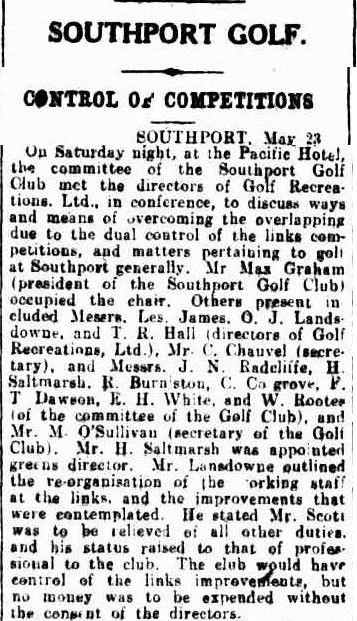
Our first Captain, J. N. (Jack) Radcliffe
John Norman Radcliffe became the Southport Golf Club’s first Captain in 1924 and held the position until 1928.
Early Years
Jack Radcliffe was born in Queensland in 1894. He was educated at the Brisbane Grammar School and was awarded a Bachelor of Arts with Honours in Classics from the University of Queensland. He was also a talented tennis player who represented Queensland in tennis from 1912 to 1914 and was State Tennis Champion in 1921.
In 1914, Radcliffe was selected as a Rhodes Scholar. He was studying at Balliol College, Oxford, when war broke out in 1914 and he then enlisted in the Royal Garrison Artillery of the British Army. He was sent with the British Expeditionary Force to the Western Front, rising to the rank of Captain. In 1917 he was awarded the Military Cross.
After the war, he returned to Oxford to continue his studies and he represented the university at tennis and golf. He returned to Brisbane in 1919, working for the Department of Education. He joined the Brisbane Golf Club in 1922.

Golfing Prowess
Queensland Open Amateur Champion 1924, 1926, 1927, 1928.
Queensland Open winner 1933 as an amateur, defeating the professionals.
Queensland Foursomes Amateur Champion 1933, 1935.
Radcliffe distinguished himself quickly as a fine golfer on his return to Queensland. He came second in the Queensland Amateur championship in 1923 and then set about developing his stroke to achieve more flight in his shots. In 1924, he won the Amateur Championship by eight strokes.
In the 1920s, Radcliffe played off a scratch handicap and even in the 1950s, his handicap was three.
Jack Radcliffe won many trophies at Southport. In 1929, he was Southport Golf Club Champion and he set two records on the one day while playing with the club professional, Mr Scott – best 18-hole score of 68 strokes and best nine-hole score of 31 strokes, remembering that the 18 holes were two loops of the nine-hole course. A score of 31 strokes was eight under par.
In 1948, The South Coast Bulletin reported, “Radcliffe has always been regarded as one of the sweetest iron players this State has produced.” In 1949 he won the President’s Trophy, and he was still playing A grade pennants for Southport.
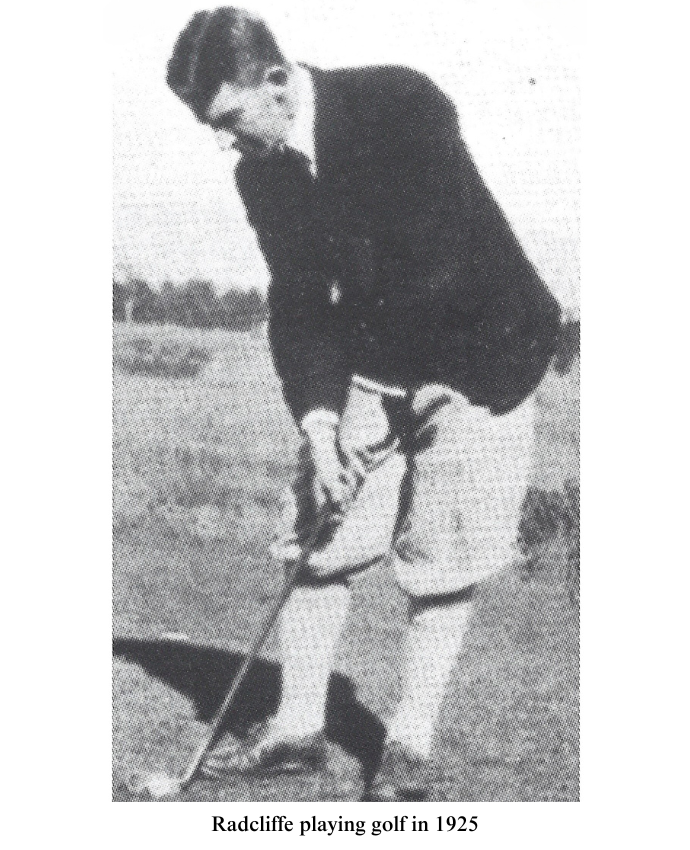
Role at Southport Golf Club
Radcliffe was at the forefront of the group who worked to create the Southport Golf Club in 1924. He visited the site of the current course in January 1924 before attending the meeting where the Southport Golf Club was formed in August 1924.
Radcliffe was the first Captain of Southport Golf Club from 1924 to 1928. He went on to serve as Handicapper as well as participating on other committees, such as the Greens Committee.
In 1938, Radcliffe was one of the leaders of the club, when they leased the course from Southport Golf Recreations and changed the name of the club to Greater Southport Golf Club.

Career at The Southport School
Jack Radcliffe joined the teaching staff of The Southport School as senior master in 1923, after four years with the Department of Education in Brisbane.
Radcliffe served with distinction at The Southport School. He was installed as Headmaster in 1940, taking charge from 1941 until 1950. Radcliffe chose to step down as Headmaster in 1950, believing it was time for a younger person to take over the reins of the school. He continued to serve on staff as a senior master until his death in 1963.
Jack Radcliffe was considered a brilliant scholar, sportsman and administrator.

The first Club House 1925
The construction of the first club house was mentioned in the newspapers in March 1925.
In May 1925, the Daily Mail stated, “An up-to-date club house is at present in the course of erection, and this should add considerably to the attractions of the links. This building will be of a most unique design, its shape being that of a cross, with a roof in keeping with such a quaint building.”
The club house cost £1,000 to build. According to the Brisbane Courier on December 5, 1925, “[The club house] provides dressing rooms and locker accommodation, together with showers and a septic system. The entrance is through a vestibule, which opens on either side to the dressing rooms, and the bar accommodation is to the rear, with a kitchen at the back.”
The first club house was in use from 1925 to 1950. By 1950, it was in quite a state of disrepair and was substantially renovated.
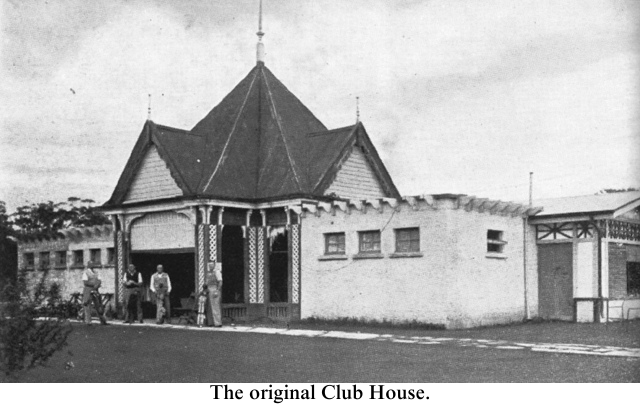
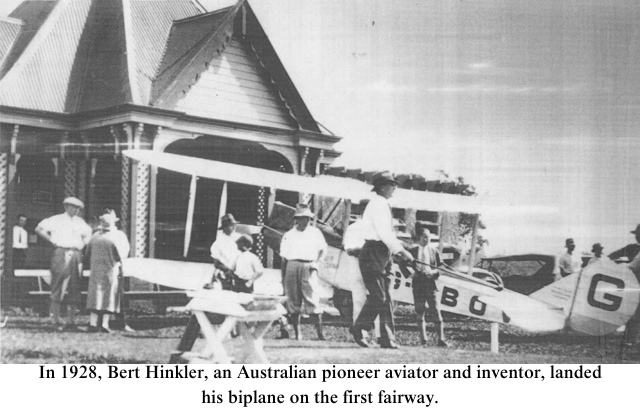
Southport Golf Club in 1931
Did you know that for the first 26 years, Southport was a nine-hole course at our current site in Bundall. What was it like?
Luckily for us, J.R. Quarton, the golf correspondent for the Brisbane Courier, wrote an extensive article on the course to promote the upcoming golf carnival to be staged at Southport during the Christmas and New Year holidays of 1931. His article was published on December 9, 1931.
SOUTHPORT GOLF – Description of Course. By J. R. QUARTON.
Situated within 50 miles [80 km] of Brisbane, and on a first-class road, Southport, long famous as a surfers’ paradise, now boasts a first-class nine-hole golf links, which annually attracts countless devotees of the royal and ancient game.
Realising the necessity of providing a real test of golfing skill, those who were responsible sought the aid of a course architect before commencing construction, and the work of laying out the links was left in the very able hands of M. T. Stafford, professional to the Brisbane Golf Club. The result of this well-known professional’s effort is a tribute to his skill, and the course today presents a wide variety of shots to delight the heart of the enthusiast.
Visitors this year will be agreeably surprised when they view the improvements made during the past 12 months. The fairways have been widened and freed from rough, all dead and unsightly timber has been removed, and wide open-cut drains have been made to quickly carry off surface water. The greens have been considerably extended and improved, tees lengthened and renovated, and the course generally presents a most pleasing picture. The club house has received attention also, and from its elevated position one commands a view of the entire playing area. The total length of the nine holes is 2851 yards [2607 metres], with a standard scratch score of 37.
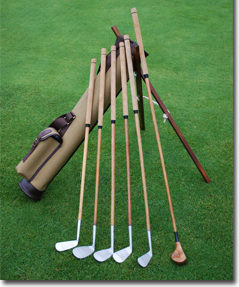

1948 Southport Golf Club buys the golf course.
1948 was a momentous year for the Southport Golf Club.
For the previous 24 years, the Club had leased the course from Southport Town Council’s entity, South Coast Recreations, later known as Southport Golf Recreations. The Golf Club did not have the right to develop the land further.
After World War Two, there was a boom and increased demand for more access to golf courses on the coast.
The members of Southport Golf Club bought the nine-hole golf course and the undeveloped land for the sum of £9000 in 1948 and then set about constructing the second nine holes.
The summary of the first five years (see image) demonstrates how proud the club members were of their achievements in the five years since buying the land. They had increased their assets and capital substantially and reduced their liabilities. Membership has also increased by approximately 75%.
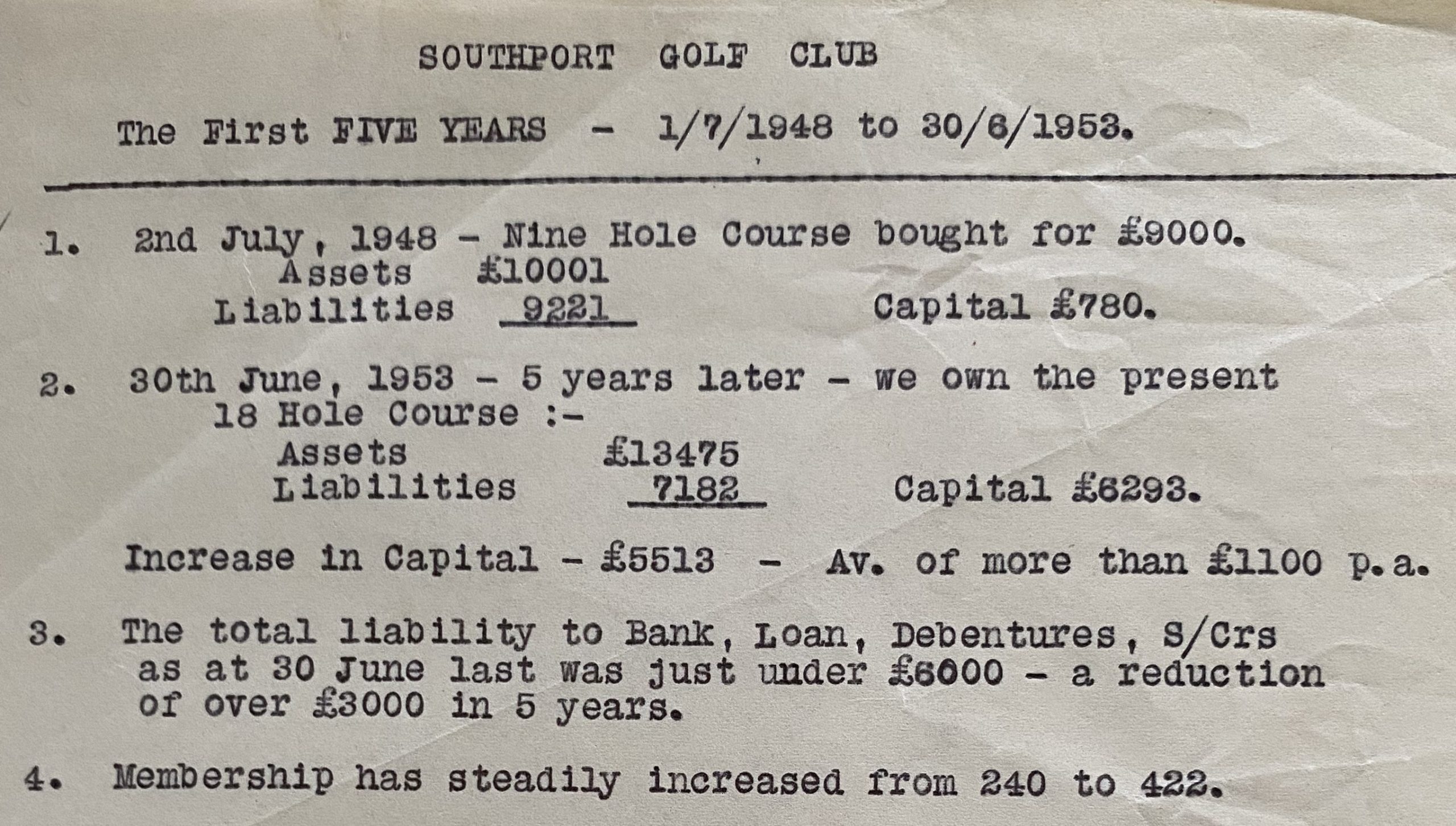
1950 Southport Golf Club has an 18 hole golf course.
Immediately after purchasing the property in 1948, the Southport Golf Club set about planning and building the second nine holes on the undeveloped land around the original nine hole course.
According to E. F. Doyle, “With the post war boom in tourist traffic on the South Coast, the Club was soon faced with the problems of course congestion, particularly at weekends when many revenue producing visitors were turned away. The remedy then obvious – eighteen holes were necessary.”
The construction of the second nine was coordinated by a small group led by E. F. (Pat) Doyle. There were not many funds available as the Club was still paying off the purchase price of the land, so the new nine was largely built with the help of members. One member had given the Club access to a bulldozer and all grading work was conducted free of charge. To save on costs, the greens were not properly constructed with rubble, ashes or piping. The Club assumed that the sandy loam soil on the greens would drain adequately. Pat Doyle noted “At a time of rising costs of labour and material, the Southport Club in six months had its second nine holes ready for play at a cost of £750.”
The second nine holes was opened in 1950. As Pat Doyle proudly stated, “In two years, what was a mediocre nine hole lay-out has today become a first rate country course of 18 holes.”
E.D. Pike, the Club President in September 1950, noted “The past year has seen a spectacular change in our course … I feel sure it will be agreed by all that more progress has been made this year in this direction, than in any other period of the Club’s existence, for in spite of very adverse weather conditions, the new 9 holes were playable in under 6 months from the date of commencement.”
Although the total length was only 2469 metres, the second nine holes was severely rated with a Standard Scratch (S.S.) of 33. Metreage and S.S. are as follows: 10th, 320 (s.s. 4): 11th, 133 (3): 12th, 306 (4): 13th, 169 (3): 14th, 398 (4): 15th, 352 (4): 16th, 389 (4): 17th, 128 (3): 18th, 274 (4).
If you would like to read more, here is an article by E. F. Doyle describing the planning and construction of the second nine holes. He includes details about the positioning of the greens and fairways, as well as the finishing of the greens, fairways and drainage.
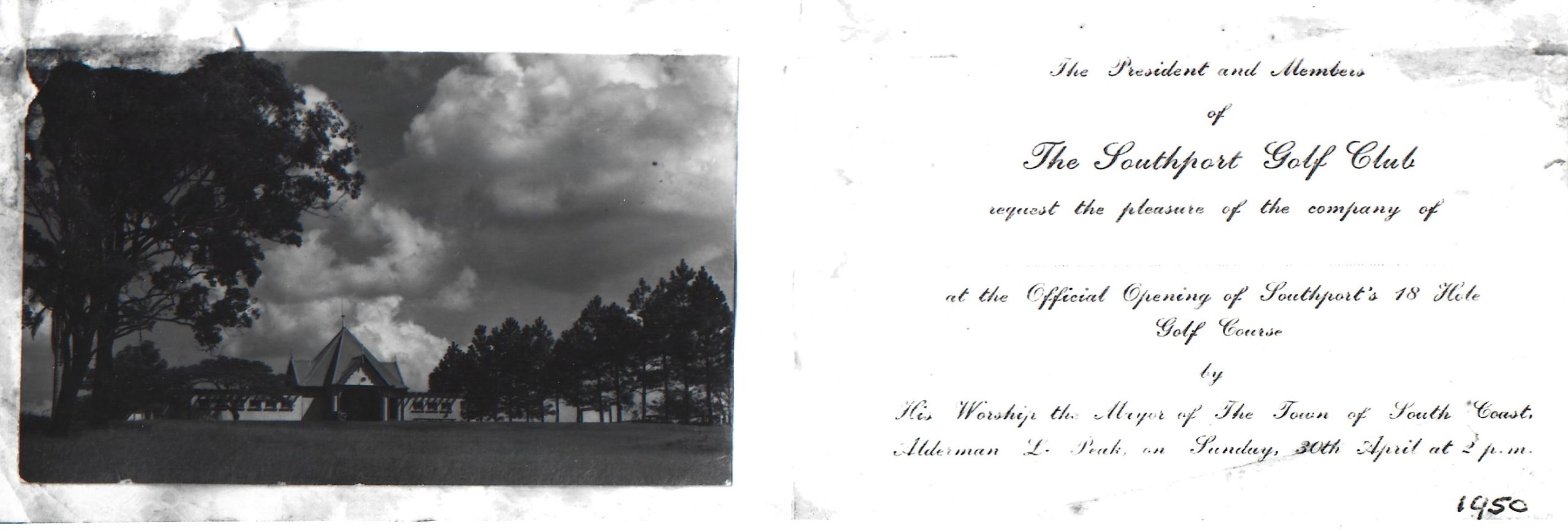
Invitation to the Opening of the 18 Hole Golf Course, 1950.
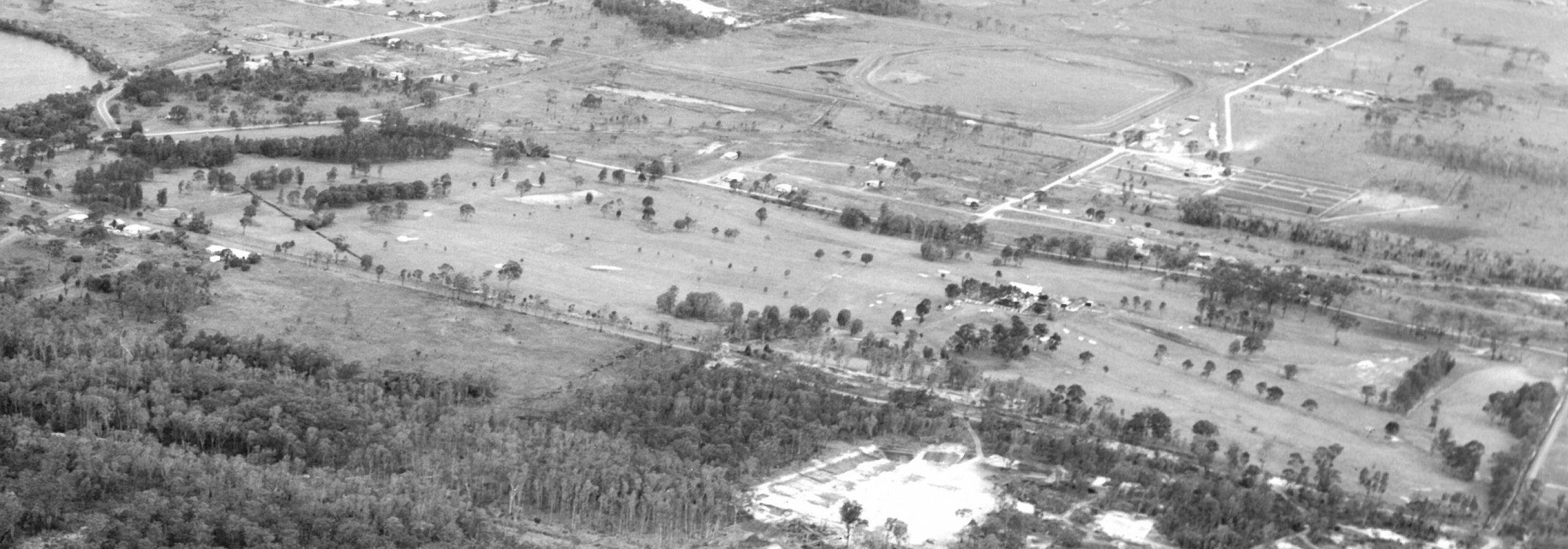
Aerial view of the Southport Golf Club in the 1950s.
Note the race course at the top of the photo. Slatyer Ave was a dead-end road which finished just west of the course. Shaw Street was a connecting road which ran through to the area west of the course.
Source of the image – Gold Coast Libraries Local Studies Collection. Photographer unidentified.
The Second Clubhouse.
After the completion of the 18 hole course in 1950, the next major project was renovation of the clubhouse.
In 1951, there was discussion of the poor state of the clubhouse. The roof needed repairs and there were electrical issues. At the northern end of the building, three posts were taking the weight of the roof; however, they were rotting at the base owing to poor drainage. Some fascia needed attention and in places some windows were falling out. Various criticisms included the “Club House is falling into disrepair” and “we must protect our asset and the longer the delay, the bigger the job.”
In 1954, alterations were made to the clubhouse, and they cost approximately £11,000. The building was extended, and the pitched roof was removed, and a more modern roof line was constructed.
In 1975, another major renovation took place on the clubhouse, this time with a cost estimated at $150,000. The clubhouse official opening was held in November 1975, with 239 members attending.
Long standing members of the club remember the second clubhouse most fondly. Some remember the “awesome” atmosphere in the clubhouse, with members coming out to support the players in championships, with celebrations afterwards. There were also many dinner dances and other functions held in the clubhouse. Others remember late night euchre games that took place after AllSports golf games on a Tuesday.
Many members have spoken most fondly of Mrs Mac – Mrs Macnamara – who, with her husband, ran the catering in the clubhouse for many years. She was very knowledgeable about the players in competitions and championships and “ran a tight ship”. Mr Mac was the cook, and his delicious pies were often mentioned by the members.
The second clubhouse was in use until 1995, when the current clubhouse was completed.

An early photo of the 2nd clubhouse.
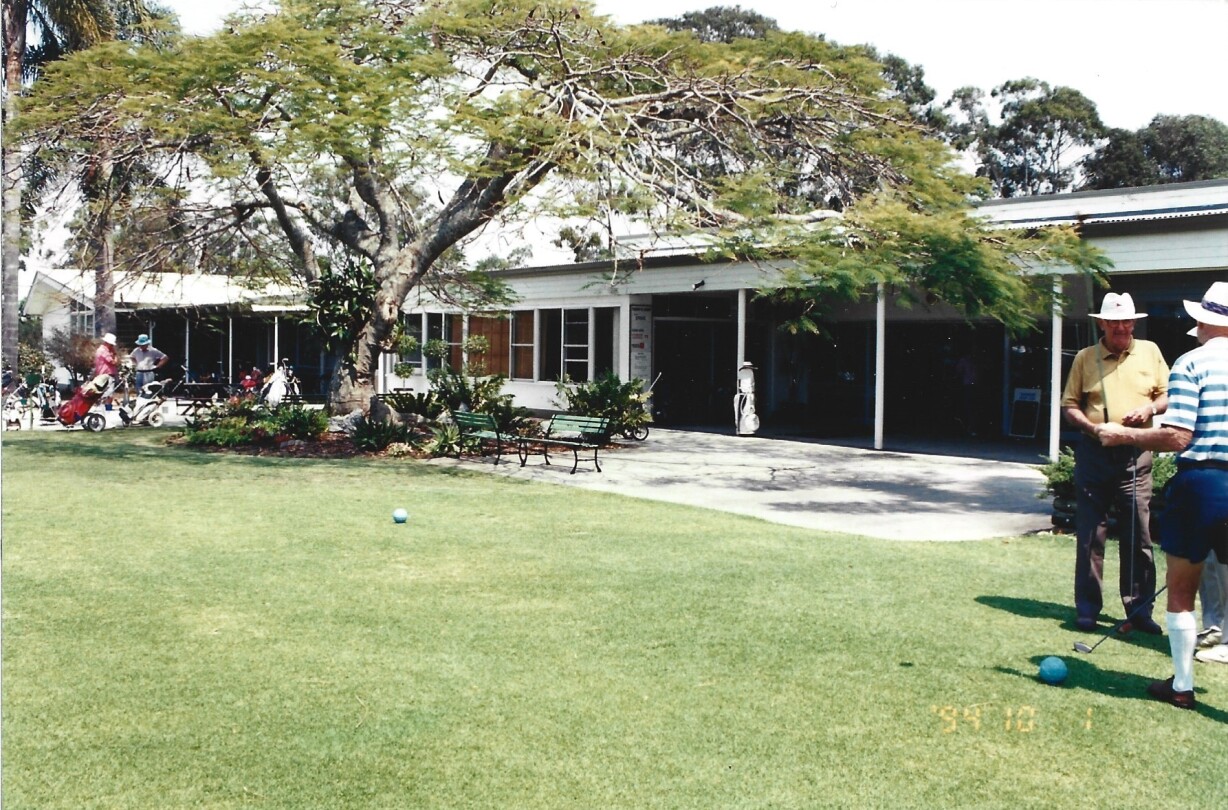
Aerial view of the Southport Golf Club in the 1950s.
Note the race course at the top of the photo. Slatyer Ave was a dead-end road which finished just west of the course. Shaw Street was a connecting road which ran through to the area west of the course.
Source of the image – Gold Coast Libraries Local Studies Collection. Photographer unidentified.
